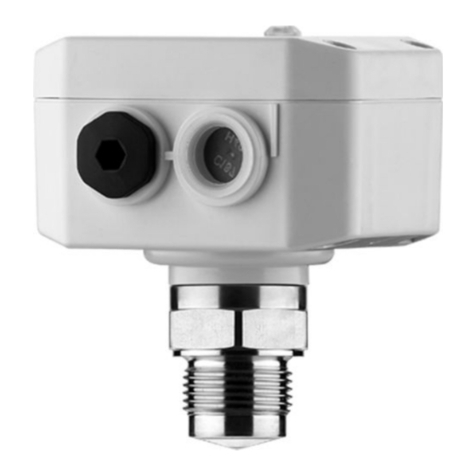Vega VEGAPULS 63 User manual

Operating Instructions
VEGAPULS 63
4 … 20 mA/HART - four-wire
Document ID: 28441

2
Contents
VEGAPULS 63 • 4 … 20 mA/HART - four-wire
28441-EN-170119
Contents
1 About this document
1.1 Function ........................................................................................................................... 4
1.2 Target group ..................................................................................................................... 4
1.3 Symbols used................................................................................................................... 4
2 For your safety
2.1 Authorised personnel ....................................................................................................... 5
2.2 Appropriate use................................................................................................................ 5
2.3 Warning about incorrect use............................................................................................. 5
2.4 General safety instructions............................................................................................... 5
2.5 Safety label on the instrument .......................................................................................... 5
2.6 EU conformity................................................................................................................... 6
2.7 FulllmentofNAMURrecommendations ......................................................................... 6
2.8 FCC/IC conformity (only for USA/Canada) ....................................................................... 6
2.9 Environmental instructions ............................................................................................... 6
3 Product description
3.1 Conguration.................................................................................................................... 8
3.2 Principle of operation........................................................................................................ 9
3.3 Packaging, transport and storage................................................................................... 10
3.4 Accessories and replacement parts ............................................................................... 11
4 Mounting
4.1 General instructions ....................................................................................................... 12
4.2 Mountinginstructions ..................................................................................................... 13
5 Connecting to power supply
5.1 Preparing the connection ............................................................................................... 20
5.2 Connection procedure.................................................................................................... 21
5.3 Wiring plan, double chamber housing ............................................................................ 22
5.4 Switch-on phase............................................................................................................. 24
6 Set up with the display and adjustment module PLICSCOM
6.1 Short description ............................................................................................................ 25
6.2 Insert display and adjustment module............................................................................ 25
6.3 Adjustment system......................................................................................................... 26
6.4 Setup steps .................................................................................................................... 27
6.5 Menuschematic............................................................................................................. 38
6.10 Saving the parameterisation data................................................................................... 40
7 Set up with PACTware and other adjustment programs
7.1 Connect the PC.............................................................................................................. 41
7.2 Parameter adjustment with PACTware............................................................................ 42
7.3 ParameteradjustmentwithAMS™andPDM................................................................. 43
7.4 Saving the parameterisation data................................................................................... 44
8 Maintenanceandfaultrectication
8.1 Maintenance .................................................................................................................. 45
8.2 Rectify faults................................................................................................................... 45
8.3 Exchanging the electronics module................................................................................ 46
8.4 Software update ............................................................................................................. 46
8.5 How to proceed if a repair is necessary.......................................................................... 47

3
Contents
VEGAPULS 63 • 4 … 20 mA/HART - four-wire
28441-EN-170119
9 Dismount
9.1 Dismounting steps.......................................................................................................... 48
9.2 Disposal ......................................................................................................................... 48
10 Supplement
10.1 Technical data ................................................................................................................ 49
10.2 Dimensions .................................................................................................................... 55
10.3 Industrial property rights................................................................................................. 61
10.4 Trademark ...................................................................................................................... 61
Safety instructions for Ex areas
TakenoteoftheExspecicsafetyinstructionsforExapplications.
These instructions are attached as documents to each instrument
with Ex approval and are part of the operating instructions manual.
Editing status: 2017-01-11

4
1 About this document
VEGAPULS 63 • 4 … 20 mA/HART - four-wire
28441-EN-170119
1 About this document
1.1 Function
This operating instructions manual provides all the information you
need for mounting, connection and setup as well as important instruc-
tionsformaintenanceandfaultrectication.Pleasereadthisinforma-
tion before putting the instrument into operation and keep this manual
accessible in the immediate vicinity of the device.
1.2 Target group
This operating instructions manual is directed to trained specialist
personnel.The contents of this manual should be made available to
these personnel and put into practice by them.
1.3 Symbols used
Information, tip, note
This symbol indicates helpful additional information.
Caution: If this warning is ignored, faults or malfunctions can result.
Warning: If this warning is ignored, injury to persons and/or serious
damage to the instrument can result.
Danger: If this warning is ignored, serious injury to persons and/or
destruction of the instrument can result.
Ex applications
This symbol indicates special instructions for Ex applications.
SIL applications
This symbol indicates instructions for functional safety which must be
taken into account particularly for safety-relevant applications.
• List
The dot set in front indicates a list with no implied sequence.
→ Action
This arrow indicates a single action.
1 Sequence of actions
Numbers set in front indicate successive steps in a procedure.
Battery disposal
This symbol indicates special information about the disposal of bat-
teries and accumulators.

5
2 For your safety
VEGAPULS 63 • 4 … 20 mA/HART - four-wire
28441-EN-170119
2 For your safety
2.1 Authorised personnel
All operations described in this operating instructions manual must
be carried out only by trained specialist personnel authorised by the
plant operator.
During work on and with the device the required personal protective
equipment must always be worn.
2.2 Appropriate use
VEGAPULS 63 is a sensor for continuous level measurement.
Youcannddetailedinformationabouttheareaofapplicationin
chapter "Product description".
Operational reliability is ensured only if the instrument is properly
usedaccordingtothespecicationsintheoperatinginstructions
manual as well as possible supplementary instructions.
For safety and warranty reasons, any invasive work on the device
beyond that described in the operating instructions manual may be
carried out only by personnel authorised by the manufacturer. Arbi-
traryconversionsormodicationsareexplicitlyforbidden.
2.3 Warning about incorrect use
Inappropriate or incorrect use of the instrument can give rise to
application-specichazards,e.g.vesseloverllordamagetosystem
components through incorrect mounting or adjustment.
2.4 General safety instructions
This is a high-tech instrument requiring the strict observance of stand-
ard regulations and guidelines.The user must take note of the safety
instructionsinthisoperatinginstructionsmanual,thecountry-specic
installation standards as well as all prevailing safety regulations and
accident prevention rules.
Depending on the model, the emitting frequencies of all radar sensors
are either in the C or K band range.The low transmitting power lies far
below the internationally permitted limit values.When the instrument
is used correctly, it presents no danger to human health. It may be
operated without restriction outside of closed metallic vessels.
Theinstrumentmustonlybeoperatedinatechnicallyawlessand
reliable condition.The operator is responsible for trouble-free opera-
tion of the instrument.
During the entire duration of use, the user is obliged to determine the
compliance of the necessary occupational safety measures with the
current valid rules and regulations and also take note of new regula-
tions.
2.5 Safety label on the instrument
The safety approval markings and safety tips on the device must be
observed.

6
2 For your safety
VEGAPULS 63 • 4 … 20 mA/HART - four-wire
28441-EN-170119
2.6 EU conformity
ThedevicefullsthelegalrequirementsoftheapplicableEUguide-
lines.ByaxingtheCEmarking,weconrmsuccessfultestingofthe
product.
YoucanndtheEUconformitydeclarationonourwebsiteunder
www.vega.com/downloads.
Electromagnetic compatibility
The instruments are designed for use in an industrial environment.
Nevertheless, electromagnetic interference from electrical conductors
and radiated emissions must be taken into account, as is usual with a
class A instrument according to EN 61326-1. If the instrument is used
inadierentenvironment,itselectromagneticcompatibilitywithother
devices must be ensured by suitable measures.
2.7 FulllmentofNAMURrecommendations
NAMURistheautomationtechnologyuserassociationintheprocess
industryinGermany.ThepublishedNAMURrecommendationsare
acceptedasthestandardineldinstrumentation.
ThedevicefullstherequirementsofthefollowingNAMURrecom-
mendations:
• NE 21 – Electromagnetic compatibility of equipment
• NE 43 – Signal level for malfunction information from measuring
transducers
• NE53–Compatibilityofelddevicesanddisplay/adjustment
components
For further information see www.namur.de.
2.8 FCC/IC conformity (only for USA/Canada)
VEGAPULS sensors with all antenna versions are FCC/IC approved.
ModicationsnotexpresslyapprovedbyVEGAwillleadtoexpiryof
the operating licence according to FCC/IC.
VEGAPULS 63 is in conformity with part 15 of the FCC directives and
fulllstheRSS-210regulations.Notethecorrespondingregulations
for operation:
• This device may not cause interference, and
• The device must be resistant to interference signals, including
such that may cause undesired operating states of the device
According to chapter "Dimensions" of this operating instructions
manual, the instrument is designed for operation with an antenna with
amax.amplicationof33dB.Theinstrumentmustnotbeoperated
withantennasnotlistedthereinorthosehavinganamplicationof
morethan33dB.Therequiredantennaimpedanceis50Ω.
2.9 Environmental instructions
Protection of the environment is one of our most important duties.
That is why we have introduced an environment management system
with the goal of continuously improving company environmental pro-

7
2 For your safety
VEGAPULS 63 • 4 … 20 mA/HART - four-wire
28441-EN-170119
tection.Theenvironmentmanagementsystemiscertiedaccording
to DIN EN ISO 14001.
Pleasehelpusfullthisobligationbyobservingtheenvironmental
instructions in this manual:
• Chapter "Packaging, transport and storage"
• Chapter "Disposal"

8
3 Product description
VEGAPULS 63 • 4 … 20 mA/HART - four-wire
28441-EN-170119
3 Product description
3.1 Conguration
The VEGAPULS 63 radar sensor is available in two electronics ver-
sions:
• Standard electronics type PS60KV
• Electronics with increased sensitivity type PS60KE
The respective version can be determined by means of the type label
on the electronics.
TheelectronicsversioninuencestheCEconformity,thefactoryset-
ting for the medium selection and vessel form, the accuracy as well
astheapprovalsofVEGAPULS63.Thedierencesarelistedinthe
respective sections of this operating instructions manual.
The scope of delivery encompasses:
• Radar sensor
• Documentation
– Quick setup guide VEGAPULS 63
– Instructions for optional instrument features
– Ex-specic"Safety instructions" (with Ex versions)
– Ifnecessary,furthercerticates
• DVD "Software", included therein
– PACTware/DTMCollection
– Driver software
Information:
In this operating instructions manual, the optional instrument features
are described.The respective scope of delivery results from the order
specication.
The VEGAPULS 63 consists of the components:
• Processttingwithencapsulatedantennasystem
• Housing with electronics
• Housing cover, optionally available with display and adjustment
modulePLICSCOM
Thecomponentsareavailableindierentversions.
Versions
Scope of delivery
Constituent parts

9
3 Product description
VEGAPULS 63 • 4 … 20 mA/HART - four-wire
28441-EN-170119
1
2
3
Fig. 1: VEGAPULS 63 - ange version with Alu double chamber housing
1 Housing cover with integrated PLICSCOM (optional)
2 Housing with electronics
3 Process tting with encapsulated antenna system
Thetypelabelcontainsthemostimportantdataforidenticationand
use of the instrument:
• Instrument type
• Article and serial number device
• Article numbers, documentation
• Technicaldata:Approvals,antennatype,processtting,process
seal/temperature, signal output, voltage supply, protection, protec-
tion class
• SILidentication(withSILratingexworks)
With the serial number, you can access the delivery data of the instru-
ment via "www.vega.com", "VEGA Tools" and "Instrument search".
Youcanndtheserialnumberontheinsideoftheinstrumentaswell
as on the type label on the outside.
This operating instructions manual applies to the following instrument
versions:
• Hardwareversion≤1.10
• Softwareversion≤3.90
3.2 Principle of operation
VEGAPULS 63 is a radar sensor in K-band technology (emitting
frequencyapprox.26GHz)forcontinuouslevelmeasurement.Itis
particularly suitable for small vessels that contain aggressive liquids
under easy process conditions.
Type label
Scope of this operating
instructions manual
Application area

10
3 Product description
VEGAPULS 63 • 4 … 20 mA/HART - four-wire
28441-EN-170119
The electronics version "Increased sensitivity" enables the use of
VEGAPULS63alsoinapplicationswithverypoorreectiveproper-
ties or products with low ervalue.
The antenna of the radar sensor emits short radar pulses with a
durationofapprox.1ns.Thesepulsesarereectedbytheproduct
and received by the antenna as echoes.The transit time of the radar
pulses from emission to reception is proportional to the distance and
hence to the level.The determined level is converted into an appropri-
ate output signal and outputted as measured value.
Four-wire electronics with separate power supply.
Thesupplyvoltagerangecandierdependingontheinstrument
version.
Thedataforpowersupplyarespeciedinchapter"Technical data".
Measuredvaluetransmissioniscarriedoutviathe4…20mA/HART
output separate from power supply.
The backlight of the display and adjustment module is powered by
the sensor. The prerequisite for this is a supply voltage at a certain
level.Theexactvoltagespecicationsarestatedinchapter"Technical
data".
3.3 Packaging, transport and storage
Your instrument was protected by packaging during transport. Its
capacity to handle normal loads during transport is assured by a test
based on ISO 4180.
The packaging of standard instruments consists of environment-
friendly, recyclable cardboard. For special versions, PE foam or PE
foil is also used. Dispose of the packaging material via specialised
recycling companies.
Transport must be carried out in due consideration of the notes on the
transport packaging. Nonobservance of these instructions can cause
damage to the device.
The delivery must be checked for completeness and possible transit
damage immediately at receipt. Ascertained transit damage or con-
cealed defects must be appropriately dealt with.
Up to the time of installation, the packages must be left closed and
stored according to the orientation and storage markings on the
outside.
Unless otherwise indicated, the packages must be stored only under
the following conditions:
• Not in the open
• Dry and dust free
• Not exposed to corrosive media
• Protected against solar radiation
• Avoiding mechanical shock and vibration
Functional principle
Voltage supply
Packaging
Transport
Transport inspection
Storage

11
3 Product description
VEGAPULS 63 • 4 … 20 mA/HART - four-wire
28441-EN-170119
• Storage and transport temperature see chapter "Supplement -
Technical data - Ambient conditions"
• Relative humidity 20 … 85 %
3.4 Accessories and replacement parts
ThedisplayandadjustmentmodulePLICSCOMisusedformeasured
value indication, adjustment and diagnosis. It can be inserted into the
sensor and removed at any time.
Youcanndfurtherinformationintheoperatinginstructions"Display
and adjustment module PLICSCOM" (Document-ID 27835).
The interface adapter VEGACONNECT enables the connection of
communication-capable instruments to the USB interface of a PC. For
parameter adjustment of these instruments, an adjustment software
suchasPACTwarewithVEGA-DTMisrequired.
Youcanndfurtherinformationintheoperatinginstructions"Interface
adapter VEGACONNECT" (Document-ID 32628).
The VEGADIS 81 is an external display and adjustment unit for VEGA
plics®sensors.
For sensors with double chamber housing the interface adapter
"DISADAPT" is also required for VEGADIS 81.
Youcanndfurtherinformationintheoperatinginstructions
"VEGADIS 81" (Document-ID 43814).
VEGADIS 82 is suitable for measured value indication and adjustment
of sensors with HART protocol. It is looped into the 4 … 20 mA/HART
signal cable.
Youcanndfurtherinformationintheoperatinginstructions
"VEGADIS 82" (Document-ID 45300).
The protective cover protects the sensor housing against soiling and
intense heat from solar radiation.
Youwillndadditionalinformationinthesupplementaryinstructions
manual "Protective cover" (Document-ID 34296).
Flangesareavailableindierentversionsaccordingtothefollowing
standards: DIN 2501, EN 1092-1, ANSI B 16.5, JIS B 2210-1984,
GOST 12821-80.
Youcanndadditionalinformationinthesupplementaryinstructions
manual "Flanges according to DIN-EN-ASME-JIS" (Document-ID
31088).
Electronics module "VEGAPULS series 60" is a replacement part for
radarsensorsofVEGAPULSseries60.Adierentversionisavailable
for each type of signal output.
Youcanndfurtherinformationintheoperatinginstructions"Elec-
tronics module VEGAPULS series 60" (Document-ID 30176).
Storage and transport
temperature
PLICSCOM
VEGACONNECT
VEGADIS 81
VEGADIS 82
Protective cover
Flanges
Electronics module

12
4Mounting
VEGAPULS 63 • 4 … 20 mA/HART - four-wire
28441-EN-170119
4 Mounting
4.1 General instructions
Select an installation position you can easily reach for mounting and
connectingaswellaslaterretrottingofadisplayandadjustment
module.The housing can be rotated by 330° without the use of any
tools.You can also install the display and adjustment module in four
dierentpositions(eachdisplacedby90°).
Use the recommended cables (see chapter "Connecting to power
supply") and tighten the cable gland.
You can give your instrument additional protection against moisture
penetration by leading the connection cable downward in front of the
cableentry.Rainandcondensationwatercanthusdraino.Thisap-
plies mainly to outdoor mounting as well as installation in areas where
high humidity is expected (e.g. through cleaning processes) or on
cooled or heated vessels.
Fig. 2: Measures against moisture ingress
Metric threads
In the case of instrument housings with metric thread, the cable
glands are screwed in at the factory. They are sealed with plastic
plugs as transport protection.
You have to remove these plugs before electrical connection.
NPTthread
In the case of instrument housings with self-sealing NPT threads, it is
not possible to have the cable entries screwed in at the factory. The
free openings for the cable glands are therefore covered with red dust
protection caps as transport protection.
Prior to setup you have to replace these protective caps with ap-
proved cable glands or close the openings with suitable blind plugs.
The reference plane for the measuring range of the sensors is the
loweredgeoftheange.
Information:
If the medium reaches the antenna, buildup can form on it and cause
faulty measurements later on.
Installation position
Moisture
Cableentries-NPT
thread
Cable glands
Measuring range

13
4Mounting
VEGAPULS 63 • 4 … 20 mA/HART - four-wire
28441-EN-170119
1 32
100%
0%
4
Fig. 3: Measuring range (operating range) and max. measuring distance
1 full
2 empty (max. measuring distance)
3 Measuring range
4 Reference plane
The emitted radar impulses of VEGAPULS 63 are electromagnetic
waves.The polarisation plane is the direction of the electrical share.
Their position is marked on the instrument.
1
Fig. 4: Position of the polarisation plane of VEGAPULS 63
1 Marking hole
Makesurethatallpartsoftheinstrumentcomingindirectcontact
with the process, especially the sensor element, process seal and
processtting,aresuitablefortheexistingprocessconditions,such
as process pressure, process temperature as well as the chemical
properties of the medium.
Youcanndthespecicationsinchapter"Technical data" and on the
nameplate.
4.2 Mounting instructions
TheangescrewsofVEGAPULS63mustbealwaysscrewedwith
the torque stated in the technical data so that the PTFE washer of the
encapsulated antenna system seals.
You can counteract the material-induced tension loss with PTFE by
doing the following:
Polarisation plane
Suitability for the process
conditions
Mounting of instruments
withPTFE-coatedanges

14
4Mounting
VEGAPULS 63 • 4 … 20 mA/HART - four-wire
28441-EN-170119
1. Makesurethenumberofangescrewscorrespondstothenum-
berofangeholes
2. Usediscspringsinadditiontotheangescrewsforfasteningthe
ange
3. Tightenthescrewssteadilywiththetorquespeciedinthetechni-
cal data
When mounting the VEGAPULS 63, keep a distance of at least
200 mm (7.874 in) to the vessel wall. If the sensor is installed in the
center of dished or round vessel tops, multiple echoes can arise.
These can, however, be suppressed by an appropriate adjustment
(see chapter "Setup").
If you cannot maintain this distance, you should carry out a false
signal suppression during setup.This applies particularly if buildup on
the vessel wall is expected. In such cases, we recommend repeating
the false signal suppression at a later date with existing buildup.
> 200 mm
(7.87
")
Fig. 5: Mounting on round vessel tops
1 Reference plane
2 Vessel center or symmetry axis
In vessels with conical bottom it can be advantageous to mount the
sensor in the centre of the vessel, as measurement is then possible
down to the bottom.
Installation position

15
4Mounting
VEGAPULS 63 • 4 … 20 mA/HART - four-wire
28441-EN-170119
Fig. 6: Vessel with conical bottom
Donotmounttheinstrumentsinorabovethellingstream.Makesure
thatyoudetecttheproductsurface,nottheinowingproduct.
Fig. 7: Inowing liquid
Flush mounting
The best way to mount the sensor, also with respect to cleanability,
isushonablockange(angewithoutsocketpiece)orthrougha
hygienictting.
Mounting on socket
Ifthereectivepropertiesofthemediumaregood,youcanmount
VEGAPULS63onasocketpiece.Youwillndrecommendedvalues
for socket heights in the following illustration. The socket end should
be smooth and burr-free, if possible also rounded.Then carry out a
false signal suppression.
Inowingmedium
Mounting socket

16
4Mounting
VEGAPULS 63 • 4 … 20 mA/HART - four-wire
28441-EN-170119
d
hmax.
Fig. 8: Deviating socket dimensions
In liquids, direct the sensor as perpendicular as possible to the prod-
uct surface to an achieve optimum measurement.
Fig. 9: Alignment in liquids
The mounting location of the radar sensor should be a place where no
otherequipmentorxturescrossthepathofthemicrowavesignals.
Vessel installations such as for example, ladders, limit switches, heat-
ing spirals, struts etc. can cause false echoes that interfere with the
usefulecho.Makesurewhenplanningyourmeasuringsitethatthe
radar signals have a "clear view" to the measured product.
In case of existing vessel installations, a false signal suppression
should be carried out during setup.
If large vessel installations such as struts or supports cause false
echoes, these can be attenuated through supplementary measures.
Small,inclinedsheetmetalbaesabovetheinstallationsscatterthe
radarsignalsandpreventdirectinterferingreections.
Fig. 10: Cover at, large-area proles with deectors
Sensor orientation
Vessel installations

17
4Mounting
VEGAPULS 63 • 4 … 20 mA/HART - four-wire
28441-EN-170119
If there are agitators in the vessel, a false signal suppression should
be carried out with the agitators in motion.This ensures that the
interferingreectionsfromtheagitatorsaresavedwiththebladesin
dierentpositions.
Fig. 11: Agitators
Throughtheactionoflling,stirringandotherprocessesinthevessel,
dense foams which considerably damp the emitted signals may form
on the product surface.
If foams lead to measurement errors, you should use the biggest pos-
sible radar antennas and low frequency radar sensors (C-band).
As an alternative, sensors with guided microwave can be used. These
areunaectedbyfoamgenerationandarebestsuitedforsuchap-
plications.
Byusingastandpipe,theinuenceofvesselinstallationsandturbu-
lence can be excluded. Under these prerequisites, the measurement
of products with low dielectric constant (from 1.6) is possible.
Surge or bypass tubes must extend all the way down to the requested
min. level, as measurement is only possible within the tube.
Surge pipe
Makesureyouprovidethenecessaryupperventholeinthesurge
pipe.The hole must be aligned so that it and the polarisation marking
on the sensor are in the same plane (see illustration: "Pipe antenna
system in a tank").
Agitators
Foam generation
Measurement in the
standpipe (surge or by-
pass tube)

18
4Mounting
VEGAPULS 63 • 4 … 20 mA/HART - four-wire
28441-EN-170119
max.
min.
2
1
Fig. 12: Pipe antenna system in a tank. The vent hole in the surge pipe must be
in one plane with the polarisation marking on the sensor.
1 Marking of the polarisation direction
2 Vent hole max. ø 5 mm (0.2 in)
If possible, the antenna diameter of the sensor should correspond
to the inner diameter of the tube.With VEGAPULS 63 this is approx.
40 mm (1.575 in). The sensor can be used with tube diameters be-
tween 40 … 80 mm (1.575 … 3.15 in).
Bypass tube
As an alternative to the surge pipe in the vessel, a tube system out-
side of the vessel is possible as a bypass tube. Select during setup
the function "Bypass tube".
Align the sensor in such a way that the polarisation marking on the
processttingisinthesameplaneasthetubeholesorthetubecon-
nection openings (see illustration: "VEGAPULS in a bypass tube").

19
4Mounting
VEGAPULS 63 • 4 … 20 mA/HART - four-wire
28441-EN-170119
100%
0%
1
> 300 mm
Fig. 13: VEGAPULS 63 in a bypass tube. The polarisation marking on the
process tting must be in one plane with the tube holes or the tube connection
openings.
1 Marking of the polarisation direction
When the sensor is mounted on a bypass tube, the distance from
VEGAPULS 63 to the upper tube connection should be approx.
300 mm (11.81 in) or more. In case of extremely rough tube inner
walls, you should use an inserted tube (tube in tube) or a radar sensor
with tube antenna.
Information:
WithVEGAPULS63inangeversion,thepolarisationplaneisalways
inthecenterbetweentwoangeholes.
1
2
3
4
Fig. 14: Polarisation level with ange version, view from top on the sensor and
bypass tube. The sensor housing is not shown.
1 Position of the polarisation level
2 Flange hole
3 Upper tube connection
4 Polarisation marking

20
5 Connecting to power supply
VEGAPULS 63 • 4 … 20 mA/HART - four-wire
28441-EN-170119
5 Connecting to power supply
5.1 Preparing the connection
Always keep in mind the following safety instructions:
Warning:
Connect only in the complete absence of line voltage.
• The electrical connection must only be carried out by trained
personnel authorised by the plant operator.
• If overvoltage surges are expected, overvoltage arresters should
be installed.
Supply voltage and current output are carried on separate two-wire
connection cables if reliable separation is required.The supply volt-
agerangecandierdependingontheinstrumentversion.
Thedataforpowersupplyarespeciedinchapter"Technical data".
The standard version can be operated with an earth-connected cur-
rentoutput,theExdversionmustbeoperatedwithaoatingoutput.
This instrument is designed in protection class I.To maintain this
protection class, it is absolutely necessary that the ground conductor
be connected to the internal ground terminal.Take note of the general
installation regulations.
Always connect the instrument to vessel ground (potential equalisa-
tion) or in case of plastic vessels to the next ground potential. For
this purpose there is a ground terminal on the side of the instrument
housing.
For power supply, an approved installation cable with PE conductor is
required.
The 4 … 20 mA current output is connected with standard two-wire
cable without screen. If electromagnetic interference is expected
which is above the test values of EN 61326 for industrial areas,
screened cable should be used.
Use cable with round cross section for instruments with housing and
cablegland.Toensurethesealeectofthecablegland(IPprotection
rating),ndoutwhichcableouterdiameterthecableglandissuitable
for.
Useacableglandttingthecablediameter.
If screened cable is required, we recommend connecting the cable
screen on both ends to ground potential. In the sensor, the screen
must be connected directly to the internal ground terminal.The
ground terminal on the outside of the housing must be connected to
the ground potential (low impedance).
In Ex systems, the grounding is carried out according to the installa-
tion regulations.
With the Exd version, the minus side of the signal output is galvani-
cally connected to ground via protective diodes.When connecting the
instrumenttoagroundedPLC,equalisingcurrentscanowincase
Safety instructions
Voltage supply
Connection cable
Cable screening and
grounding
Other manuals for VEGAPULS 63
12
Table of contents
Other Vega Accessories manuals

Vega
Vega VEGAFLEX 81 User manual
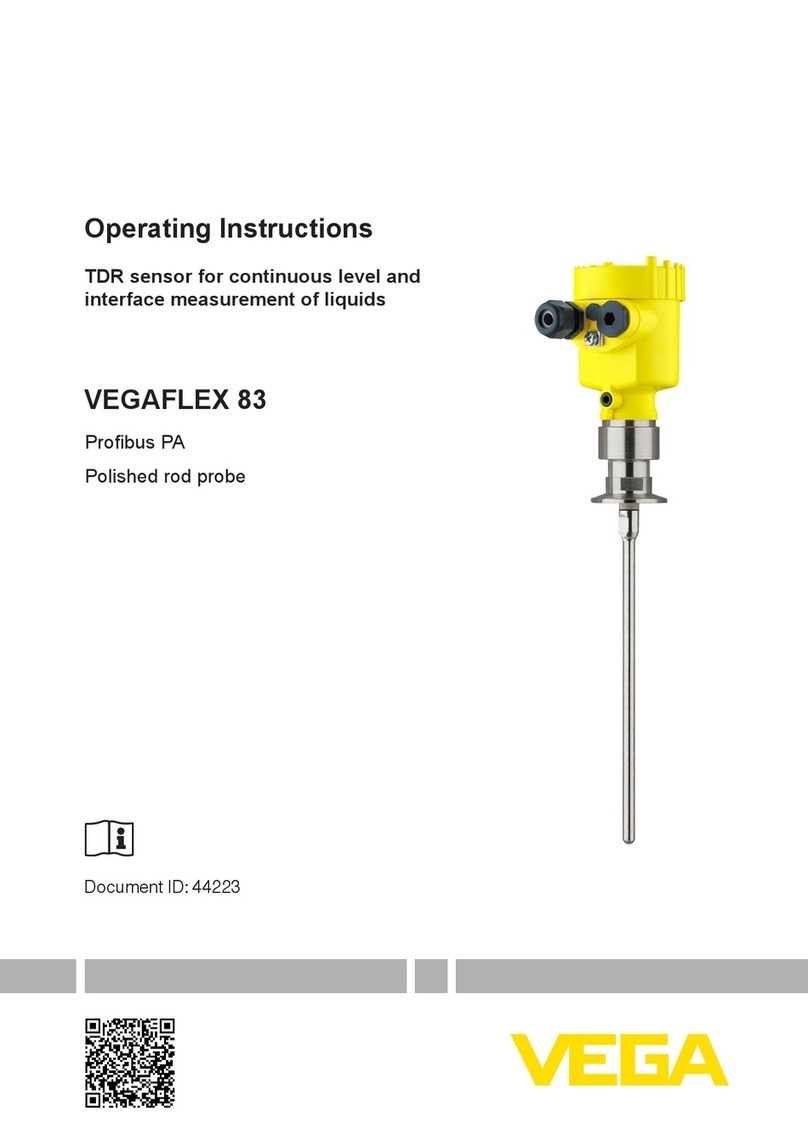
Vega
Vega vegaflex 83 User manual
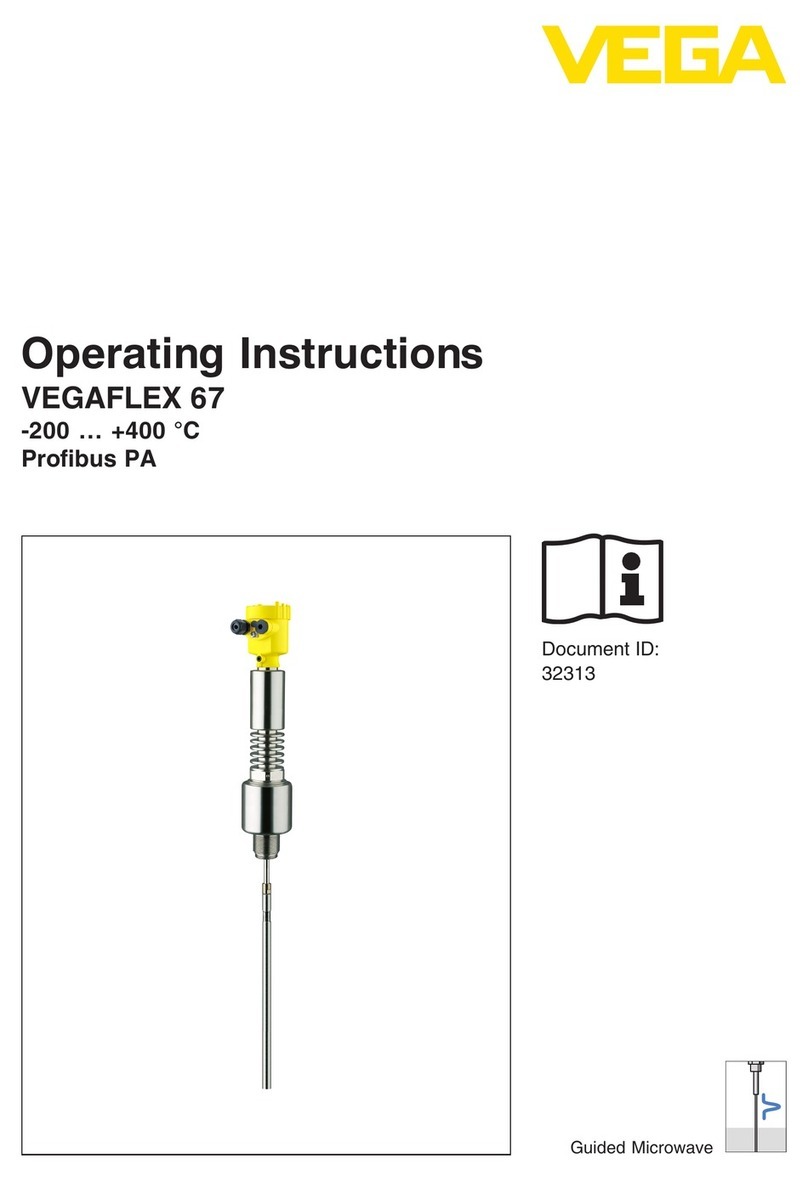
Vega
Vega VEGAFLEX 67 User manual

Vega
Vega VEGACAP 63 User manual
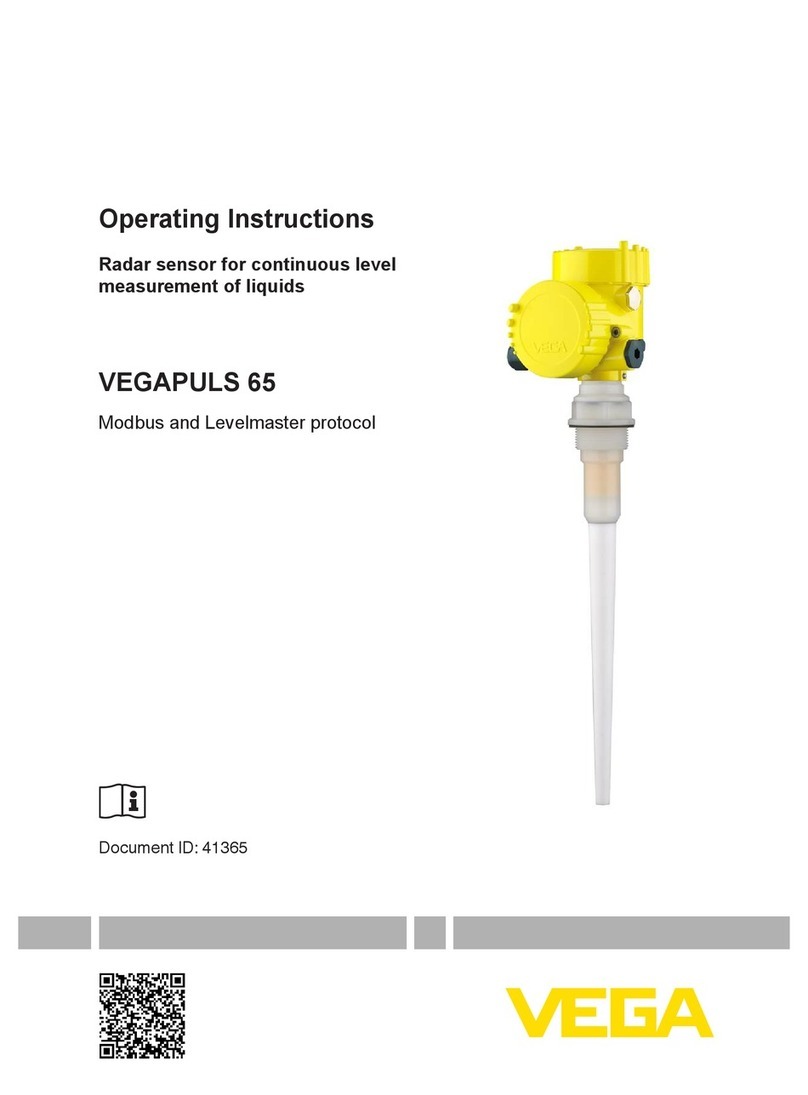
Vega
Vega VEGAPULS 65 User manual

Vega
Vega VEGAPULS 69 User manual
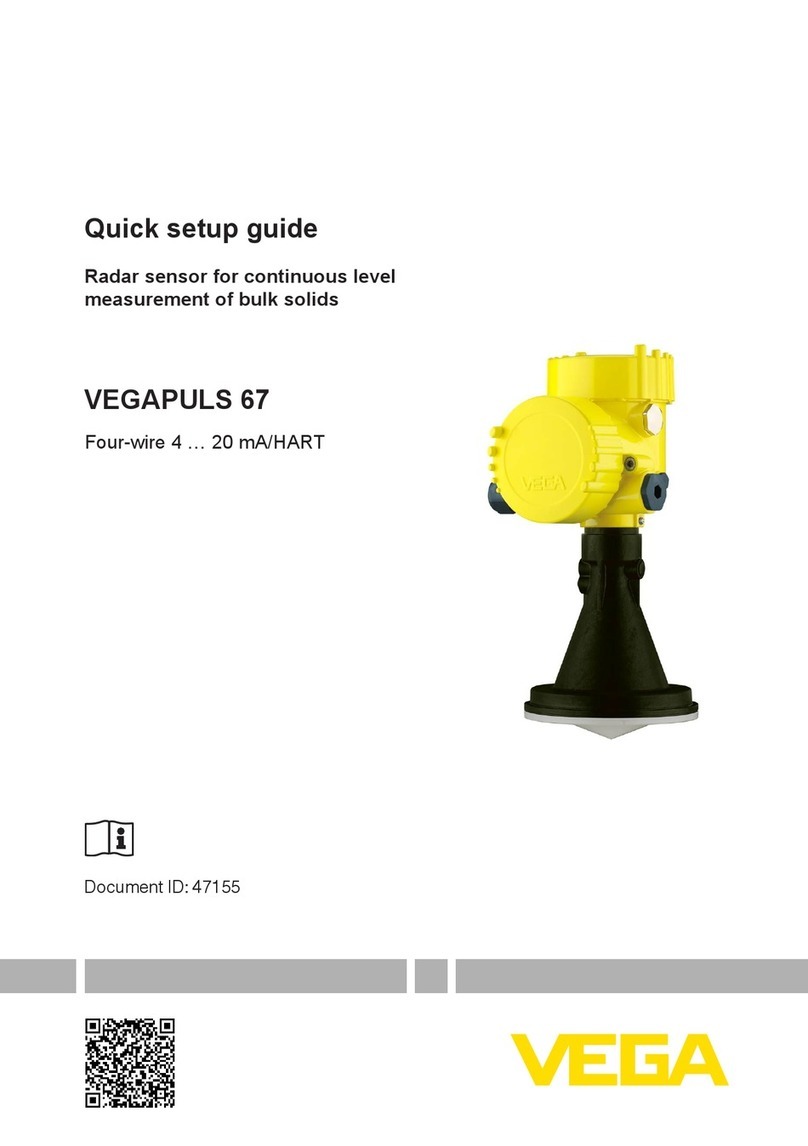
Vega
Vega VEGAPULS 67 User manual
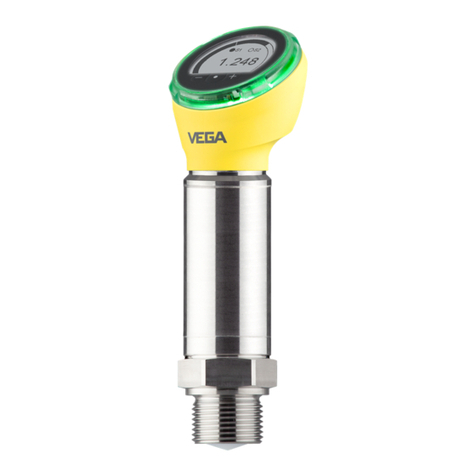
Vega
Vega VEGAPULS 42 User manual
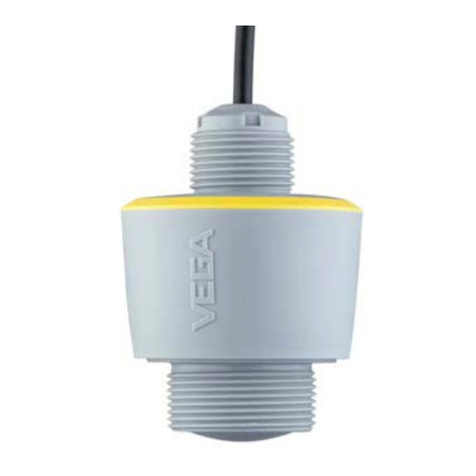
Vega
Vega VEGAPULS C 21 User manual
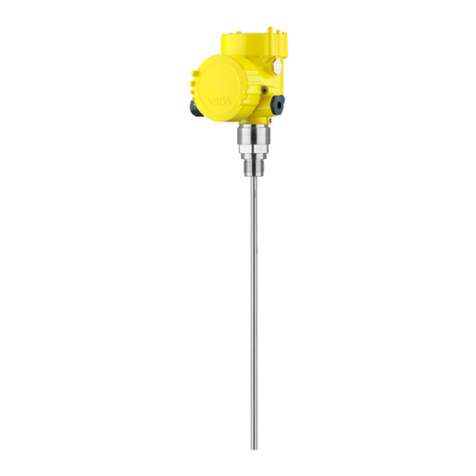
Vega
Vega VEGAFLEX 81 User manual
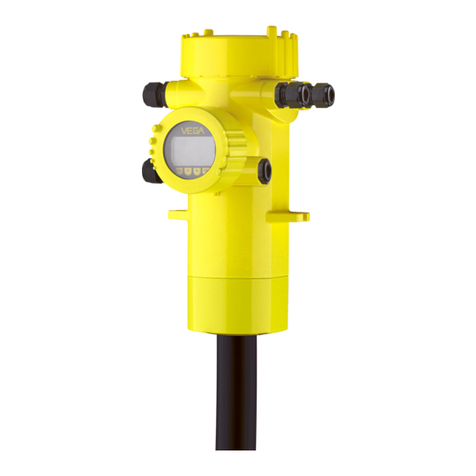
Vega
Vega FIBERTRAC 31 User manual
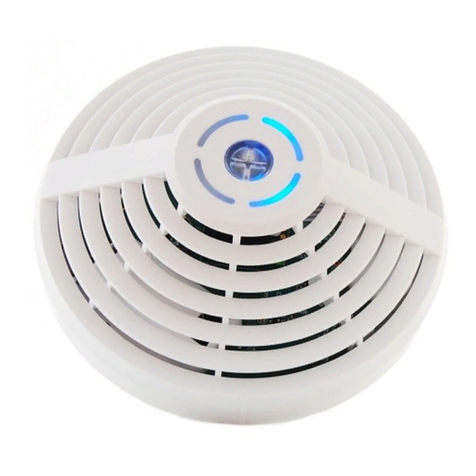
Vega
Vega SMART-SS0102 User manual
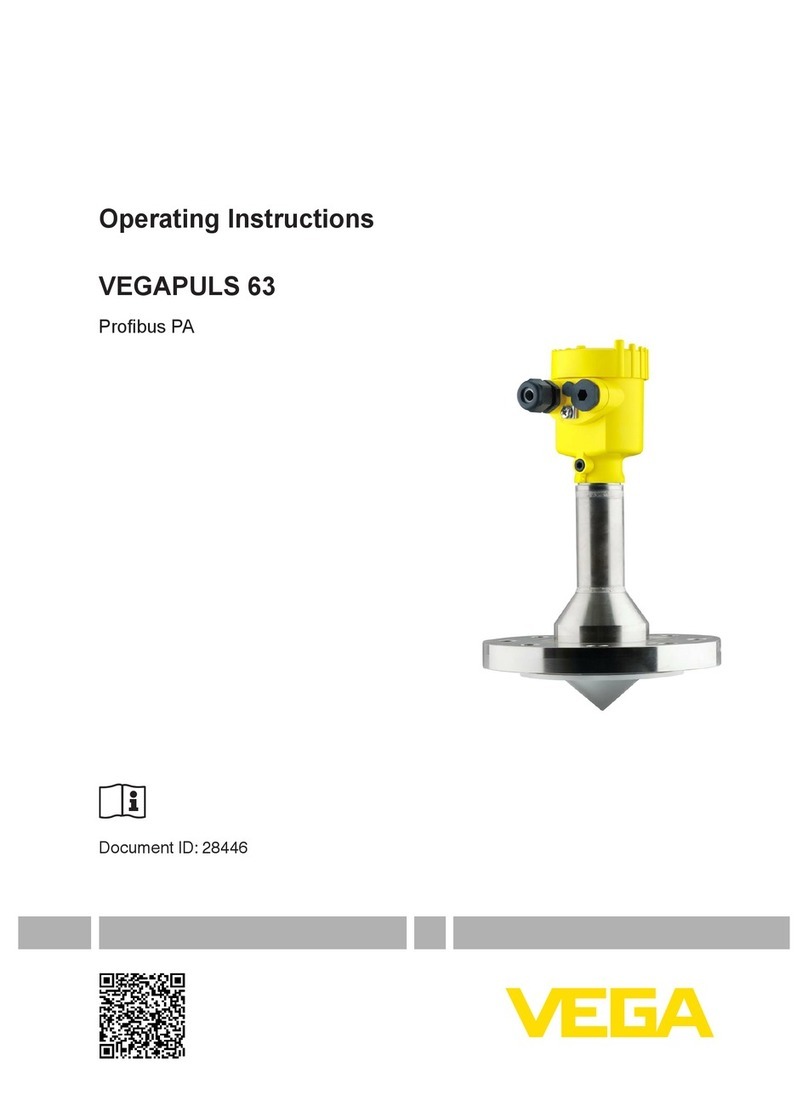
Vega
Vega VEGAPULS 63 User manual
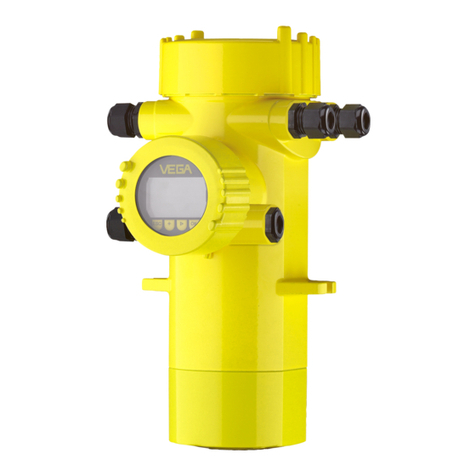
Vega
Vega MINITRAC 31 User manual
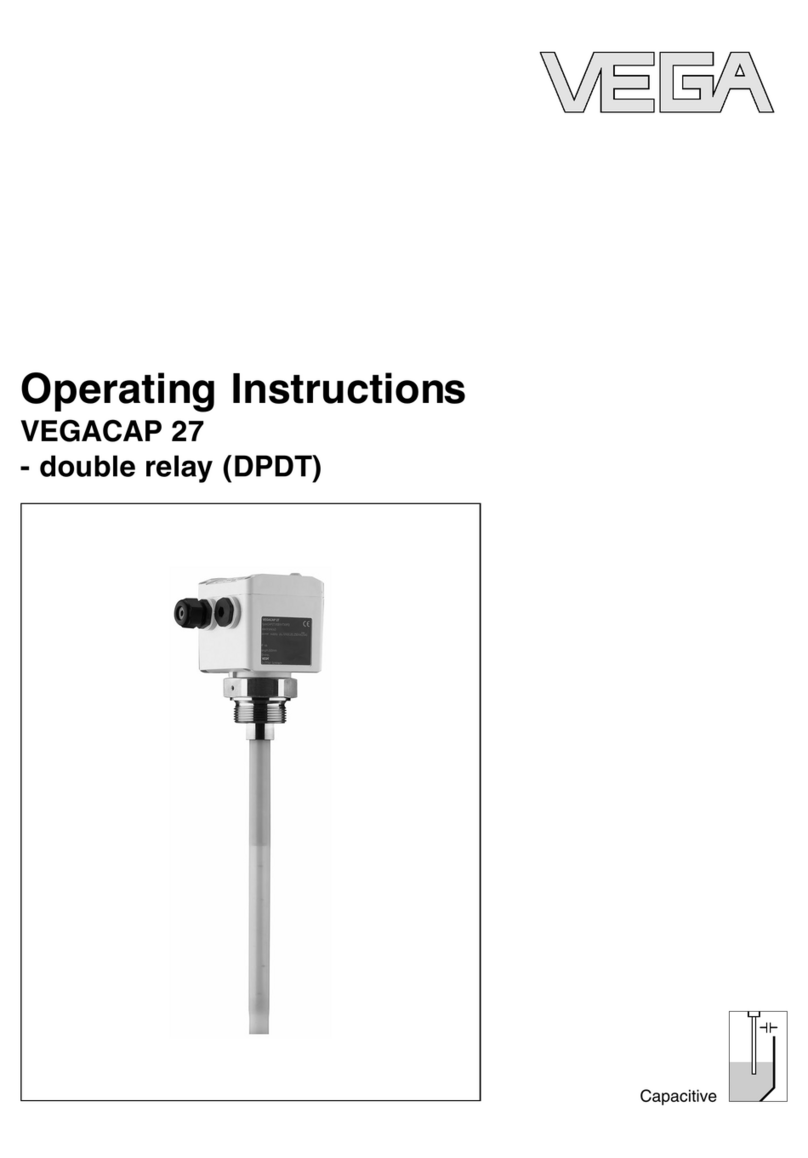
Vega
Vega VEGACAP 27 User manual
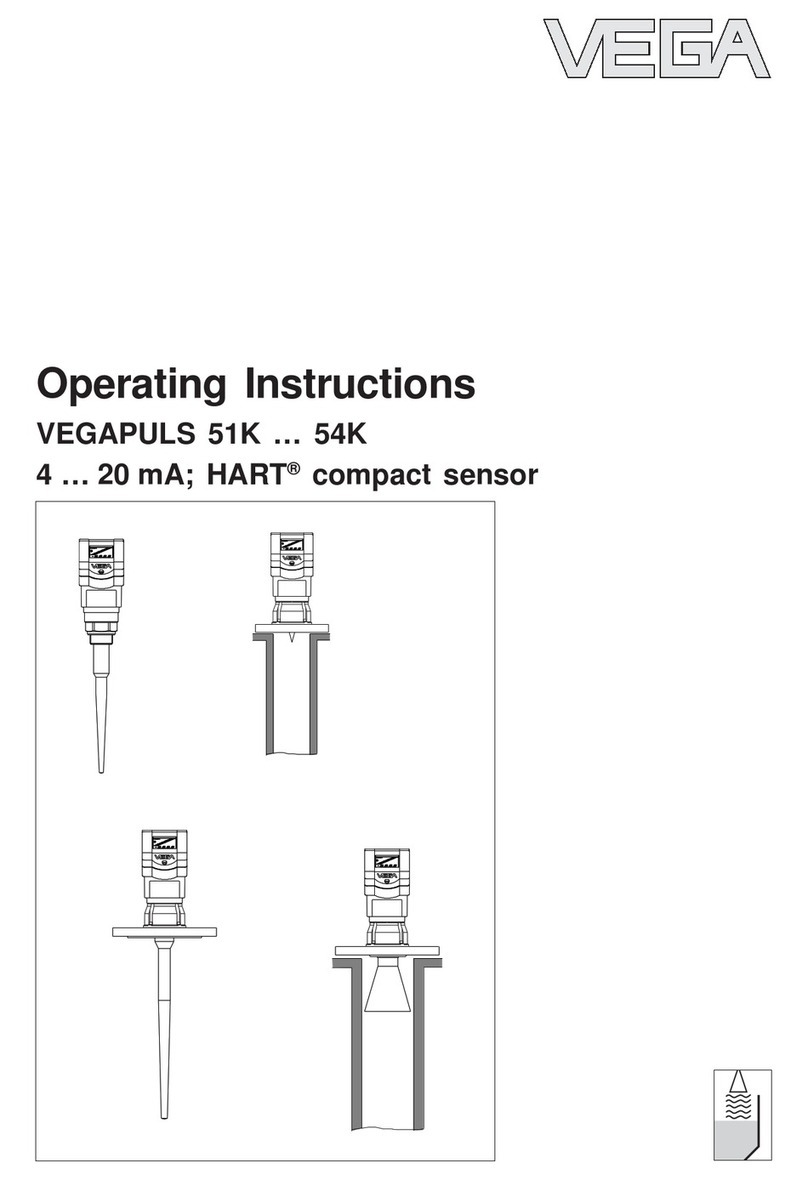
Vega
Vega VEGAPULS 51K User manual

Vega
Vega VEGAFLEX 81 User manual

Vega
Vega VEGABAR 28 User manual
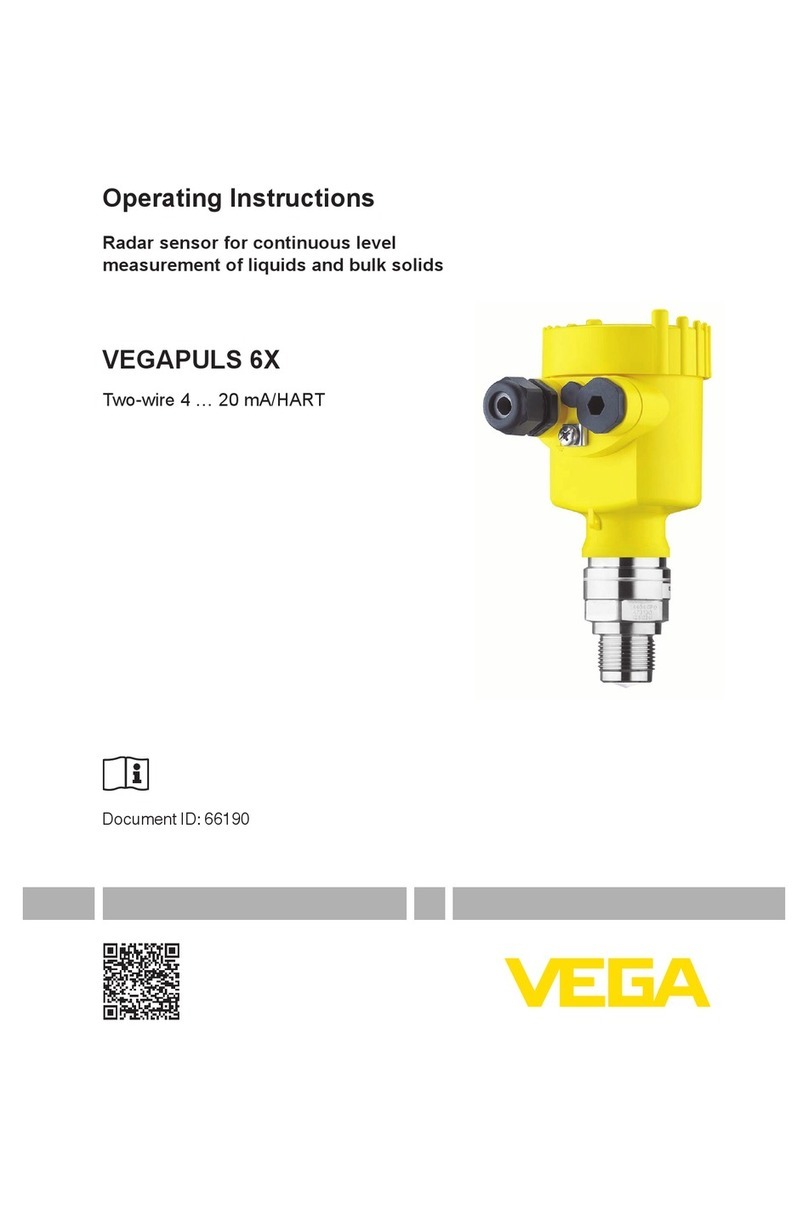
Vega
Vega VEGAPULS 6X User manual
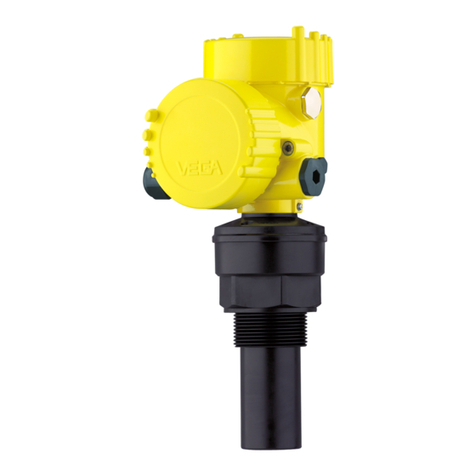
Vega
Vega VEGASON 61 User manual



